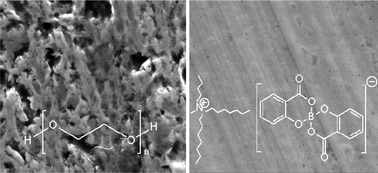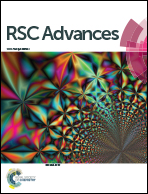Halogen-free imidazolium/ammonium-bis(salicylato)borate ionic liquids as high performance lubricant additives†
Abstract
Halogen-free bis(salicylato)borate anion based ionic liquids having imidazolium and ammonium cations, were designed, synthesized, characterized and then evaluated as potential lubricant additives. Owing to the high polarity, high London dispersive forces and high rigidity associated with the bulk size and ring structure of the bis(salicylato)borate anion, these ionic liquids possess very high viscosities. The interaction of these ionic liquids with contact surfaces has been found to be strongly influenced by the van der Waals interactions in the ionic liquids, which increases with an increase of the alkyl chain length, particularly, for the imidazolium cations. As lubricant additives, both imidazolium and ammonium ionic liquids markedly improve the friction-reducing and anti-wear properties of PEG 200 lube base. Microstructural images and element mapping of the worn surfaces of steel balls reveal that these ionic liquids form tribo-films, which reduces both the friction and wear. Being halogen-, phosphorus-, and sulfur-free, bis(salicylato)borate ionic liquids not only protect contact surfaces from tribo-corrosive events but also keep the environment green and clean. These ionic liquids offer an environmentally friendly alternative to conventional halogenated ionic liquids being currently developed for lubricant applications.


 Please wait while we load your content...
Please wait while we load your content...